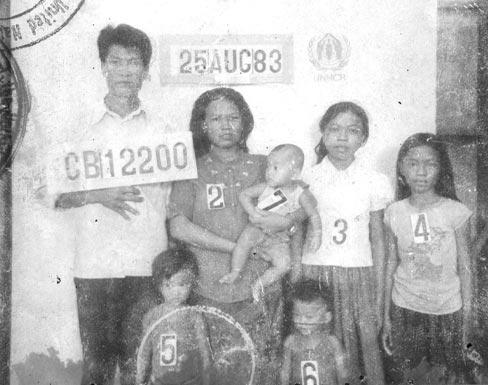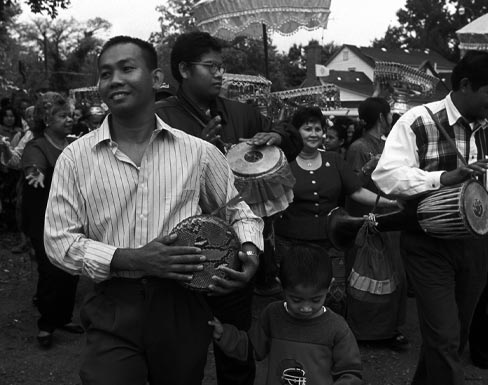Exhibit Review
From Cambodia to Greensboro: Tracing the Journeys of New North Carolinians
Greensboro Historical Museum, Greensboro, North Carolina. Project manager: Jon Zachman; guest curator: Barbara Lau
December 7, 2003-December 31, 2005
It's like you are riding on a boat, two different boats. One leg is on the Cambodian one, one leg is on the American boat. One is going east, one's going west, you're going to fall in the middle. That's when you're trapped and don't know what to decide. Why don't you buy a third boat, which you could blend it all in together, and you'll be safe. —Vandy Chhum, From Cambodia to Greensboro |
In the past 25 years, refugees and immigrants from around the globe have contributed to Greensboro, North Carolina's growing cultural diversity. Asian populations, including Cambodians, represent the largest group among the area's newcomers. As the Cambodian community celebrated the 20th anniversary of the first resettlement in Greensboro, the Greensboro Historical Museum responded with the opening of an exhibit called From Cambodia to Greensboro: Tracing the Journeys of New North Carolinians.
Established in 1924, the Greensboro Historical Museum seeks to address the region's historical events and well-known people. The museum offers exhibits on Native Americans, decorative arts, and community life. In 2000, the museum initiated a five-year strategic plan to reach new audiences, including Greensboro's diverse population, and increase community involvement. The museum used the anniversary of the Cambodian community's arrival in North Carolina in January 1983 as an opportunity to unveil the first of several new exhibits with the new goal in mind.
From Cambodia to Greensboro addresses several questions. Who were the Cambodian (Khmer) people who first came to Greensboro? Why did they leave their country? Could they make new lives in America while retaining their culture, traditions, and beliefs? The exhibit answers these questions through historical research, oral history, and community involvement. The timelines, text, and material culture are organized around five themes: Historical Roots, War and Transition, Tradition and Change, Spirituality, and Community.
The exhibit begins its journey at the golden age of the Angkor Empire and Angkor Wat, an important cultural symbol to the Khmer people. It leads visitors to a discussion of Cambodia's role in the Vietnam War and the subsequent rule of the Khmer Rouge. The narrative examines the cost of the war to the Cambodian people in human lives (2-3 million lost) and in displacement (half a million forced to flee their homeland; over 150,000 to the United States). The story line then shifts to those who began new lives in Greensboro, aided by Lutheran Family Services and other social service organizations. From Cambodia to Greensboro highlights personal struggles with identity and the measures taken to retain cultural values, religious beliefs, and traditions. The exhibit ends with a discussion of the importance of maintaining old connections and creating new ones and suggests ways that visitors can learn more about Cambodian culture, including an invitation to join in the Cambodian New Year celebration at local temples.
In the book The Presence of the Past, historians Roy Rozenweig and David Thelen suggest that the past is personal and that people trust eyewitnesses to history, as well as the information presented in museums.(1) Responding to this idea, curator Barbara Lau and researchers Vandy Chhum and Ran Kong conducted numerous interviews with first- and second-generation Cambodian Americans. Quotes from the interviews supplement the curatorial narrative. The narrative is enlivened with photographs that trace the evolution of life from refugee camps to the United States. Official government identification photographs of melancholy newly arrived Cambodians are juxtaposed with recent images of the same people at joyous occasions, including a college graduation and the birth of a grandchild.
Objects and labels work together to reinforce the educational component of From Cambodia to Greensboro. One label asks the reader to imagine life as a refugee. What would you take with you if you had to leave your home tonight? One Cambodian family chose three items as they fled their country: a cooking pot, a spoon, and a piece of fabric, which are neatly arranged in a display case. A Buddhist altar and related objects offers insight into Buddhist beliefs.
In From Cambodia to Greensboro, gallery space is transformed into a cultural meeting place. Visitors are invited to remove their shoes upon entering the gallery. Exhibit labels are printed in English and Khmer. Exhibit design reflects a Cambodian aesthetic. The brightly-colored walls and banners, traditional music playing, and the flow of the exhibit celebrate diversity and foster understanding and respect. This exhibit contributes to fulfilling the Greensboro Historical Museum's desire to broaden the scope of its mission as a local history museum and its service as an educational and cultural institution.
Karmen Bisher
National Conference of State Historic Preservation Officers
Note
1. Roy Rosenzweig and David Thelen, The Presence of the Past: Popular Uses of History in American Life (New York: Columbia University Press, 1998).


